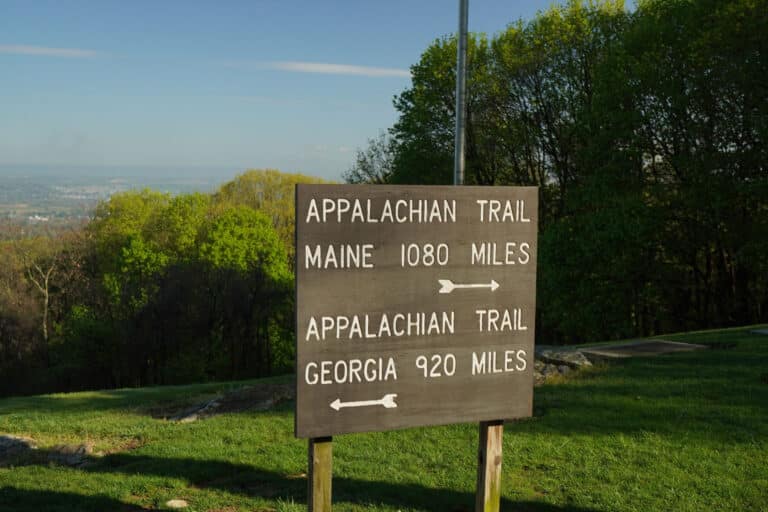IT TAKES A STRONG WILL to fall 78 times and keep getting back up. But that’s just what Trevor Thomas did on one of the last days of his thru-hike of the Appalachian Trail. Last October, Thomas became just the second blind person to hike the entire A.T. The first was Bill Irwin, who completed the trail in 1990.
In 2004, a rare degenerative eye disease started taking Thomas’ sight. But Thomas refused to let blindness interfere with his dream of walking 2,175 miles through the woods. Thomas, from Charlotte, N.C., needed to follow other hikers to be able to hike the trail, and fortunately he found a regular group of hikers willing to help him through the first part of the trail. But as fellow hikers started dropping out later in the journey, he started relying on Boy Scout troops, day hikers, or anyone else he could find. By the end, he was bruised and battered but also renewed by a spirit of adventure that transcends what can only be seen.
Blue Ridge Outdoors: What made you want to attempt a thru-hike?
Trevor Thomas: In my sighted life, I was always into extreme sports—from backcountry skiing and mountain biking to parachuting. When I was going blind, those things kept being taken away from me. It felt like my world was getting smaller, and that caused a good bit of depression. Then, one of my friends took me to see Erik Weihenmayer speak. He’s the first blind guy to climb Everest, and he had a similar eye disease. I decided that if he could do Everest, I could do something too.
BRO: What happened to your no-show hiking partner?
TT: I met a friend of a friend through the National Federation for the Blind, who trained seeing eye dogs. He would have been perfect, but at the last minute he couldn’t come. He did try to call me on my cell phone, but I had no reception. I went down to the trailhead and started asking people if I could follow their footsteps. Twenty-three people said no before someone finally said yes.
BRO: How did other people on the trail embrace you?
TT: There was a certain group that didn’t want to have anything to do with me, because they didn’t want to be responsible for getting the blind guy killed. That was a small percentage. Ninety-nine percent of the people were willing to hike with me or get water for me. I especially needed help stopping in the towns along the trail and restocking groceries, and more often than not, people were willing to help. I would recommend doing this to any blind person.
BRO: describe your hiking process.
TT: I used trekking poles instead of a cane. The poles were my eyes. I scanned the trail and found rocks with them, and I used them to make sure I was on the trail. Along the way, I learned to stay on the trail by feeling the actual ground under-neath my feet.
In Virginia I tried hiking alone, because I want-ed to have some time by myself. I developed an elaborate system where there would be people in front of me and people behind me. If for some reason I came to an intersection that made me unsure, I would stop and wait for the people coming from behind, and they would direct me. Also, if a section up ahead seemed too difficult, the people up front would stop and wait. I did 300 miles solo. That’s where I felt the most amount of accomplishment.
Thomas’ Injuries
1 Foot fracture
1 Head gash closed with Super Glue
2 Broken trekking poles
4 Broken ribs
8 Hospital visits*
78 Most falls in one day
3,000 Times falling total
* including 1 visit to a veterinary clinic in Nowhere, Maine, when he couldn’t find anyone else to treat his injuries
TT: There were a lot of those. One of the first times I hiked alone was right after Dragon’s Tooth going over McAfee knob. I made it nine miles by myself and then nearly walked off the side of a cliff. Someone heard me moving around off-trail and yelled for me to stop. I came within three feet of going off the knob.
When I hit the 100-Mile Wilderness in Maine, there was a day when I fell 78 times, and I almost drowned during three of the river crossings. There was a moment when I was sitting in a shelter by myself freezing to death when I didn’t think I could finish the last 60 miles. That was my darkest hour.
BRO: What advice did you get from Bill irwin?
TT: His biggest piece of advice to me was: don’t quit. He said, “You’re going to hate five out of seven days. It’s going to be too cold, too hot, or too something. But the days out of the week when it’s gorgeous are what you live for. And if you’re going to quit, don’t do it spur of the moment. Stop and think about it for at least three days.”
BRO: how did the trail change you?
TT: It was the most amazing experience of my entire life. The trail has changed me for the better. I’ve learned to not take things for granted. I value things by what they weigh and how it will feel on my back, as opposed to how much stuff I can accumulate in my house.
BRO: What’s next?
TT: I want the Triple Crown. I’m leaving in 2010 to make an attempt at the Pacific Crest Trail. If I can figure that one out, then I’ll do the Continental Divide.








